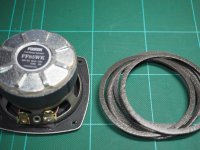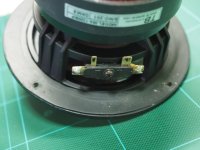Are they really necessary? This is something I’ve never seen discussed. If so, what’s the best material & method to use? I got them with my Fostex FF85K drivers years ago.
Take your pick...
https://www.parts-express.com/speak...aker-grill-cloth/Speaker-Gasketing-Tape-Caulk
Mike
https://www.parts-express.com/speak...aker-grill-cloth/Speaker-Gasketing-Tape-Caulk
Mike
For small drivers, I've used craft foam sheets from the dollar store. They are approx. 2mm thick, and come in different colours.How do you do it? What’s your material? Rubber, foam rubber, putty?
jeff
Thanks for the link. I had a box of the thicker tape, I believe, once.
Perhaps very thin rope caulk would work, a few millimeters thick, if it exists. I’m looking for something smaller for a smaller driver. I’m thinking of gasketing drivers as small as CHN-40 & ScanSpeak 5F.
Perhaps very thin rope caulk would work, a few millimeters thick, if it exists. I’m looking for something smaller for a smaller driver. I’m thinking of gasketing drivers as small as CHN-40 & ScanSpeak 5F.
How do you do it? What’s your material? Rubber, foam rubber, putty?
The very few new drivers i use that don’t come with foam gaskets i usually use closed cel foam insulation tape/darught exclusion tape. I also have a bunch of extra faom gasket material (MA often ship excess), i can make them out of.
dave
Pretty sure all the Mark Audio drivers come with gaskets, so not sure why you would need to make them?I’m thinking of gasketing drivers as small as CHN-40 & ScanSpeak 5F.
jeff
Jeff -
I’m unfamiliar with MarkAudio drivers. The CHN-40 & CHN-50 would be my first. I’ve worked with Bandor, Fostex, and ScanSpeak. I only used a gasket on the Fostex.
I’m unfamiliar with MarkAudio drivers. The CHN-40 & CHN-50 would be my first. I’ve worked with Bandor, Fostex, and ScanSpeak. I only used a gasket on the Fostex.
This past week I started printing gaskets using TPU material on the 3D printer. It really works well. I needed 40 gaskets for some 1" Aurasound Cougar drivers and this was an easy solution. I printed them 0.6 mm thick and using the ironing setting they look good. These needed to be just 2 mm wide in places, so foam tape wasn't an options. I found that a light wipe of olive oil on the print bed made these delicate parts easier to peal up. I have also had good results using poster putty. It will hold a driver in place and can be removed and reused.
I remember the gaskets being very thin.
I loved my FF85Ks, which were used in my first DIY cabs. They sadly were blown out when my then-toddler daughter cranked up the volume knob when the amp was switched off. I had a surprise when I flipped the switch. The right speaker center cap flew over my shoulder. I laugh about it now. Those were my introduction to single drivers.
I loved my FF85Ks, which were used in my first DIY cabs. They sadly were blown out when my then-toddler daughter cranked up the volume knob when the amp was switched off. I had a surprise when I flipped the switch. The right speaker center cap flew over my shoulder. I laugh about it now. Those were my introduction to single drivers.
All the MA drivers thru here, includng s few prototypes, all had gaskets, as do the Fostex. The Fountek, and i believe, the Scan did not.
TB, not sure, but i have some i can check.
dave
TB, not sure, but i have some i can check.
dave
I loved my FF85Ks, which were used in my first DIY cabs. They sadly were blown out when my then-toddler daughter cranked...
The little driver that convinced me that little FRs could do just fine up top. I have a couple used, althou 1 is supposed to be damaged, fully EnABLe that will go up or sale (near give away) soon.
dave
I used the thin white closed cell packing that's wrapped around a lot of electronic components and cut to suit. Usually it's about 0.5 to 1mm thick.
- Home
- Loudspeakers
- Full Range
- Small DIY Driver Gaskets

